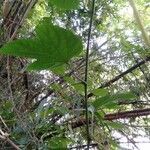Climbers, strong, to 15 m. Root tuberous. Stem and branches glabrous or puberulent, sometimes tomentose at nodes. Tendrils robust, simple. Petiole robust, 5-10 cm, slightly yellow-brown pubescent or glabrescent, 2-4-glandular at base or middle; leaf blade cordate or broadly ovate-orbicular, 10-20 × 10-20 cm, 3-5-lobed; median lobe obovate or oblong-lanceolate, 6-10(-15) × 3-6(-9) cm, margin undulate-dentate, apex acute or acuminate; lateral lobes ovate or oblong-lanceolate, 3-7(-11) × 2-4(-7) cm, base cordate. Plants dioecious. Male flowers solitary or in a short raceme; pedicels robust, 3-5 cm, or 6-12 cm when solitary, bracteate at apex; bract orbicular-reniform, 3-5 × 5-8 cm, entire, retuse at apex; calyx tube funnelform; segments broadly lanceolate or oblong, 12-20 × 6-8 mm, apex acute or acuminate; corolla yellow; segments ovate-oblong, 5-6 × 2-3 cm, yellow glandular at base, apex acute or acuminate; stamens 3; anther cells reflexed. Female flower solitary; pedicel 5-10 cm, bracteate at middle; bract ca. 2 mm; calyx and corolla as in male flowers; ovary ovoid-oblong, ca. 1 cm, densely spinescent. Fruit red, ovoid, 12-15 cm in diam., fleshy, densely spinescent, apex rostellate. Seeds numerous, ash gray, ovoid or square, 26-28 × 18-20 mm, 5-6 mm thick, both surfaces sculptured, margin undulate-sublobulate. Fl. Jun-Aug, fr. Aug-Oct.
Dioecious perennial herb, glabrous. Leaves broadly ovate to sub-orbicular, cordate at base; lamina 7–20 cm long, 8–20 cm wide, mostly 3-lobed; lobes ovate to lanceolate, entire or denticulate, acuminate, glabrous; petiole 2–10 cm long, usually with 1–4 raised glands. Male flowers: flower-scape 5–30 cm long, bracteate at top; bract sub-orbicular or reniform, 25–40 mm long, obtuse or emarginate, green to yellow; hypanthium 4–5 mm long; calyx-lobes lanceolate, 10–16 mm long; petals obovate, 25–60 mm long, yellow-orange, blackish towards base inside. Female flowers: flower-scape 3–10 mm long, bracteate about middle; bract smaller than in males; calyx-lobes subulate, 4–6 mm long; ovary ellipsoidal, 12–15 mm long, densely muricate. Fruit ellipsoidal, 10–15 cm long, 6–10 cm diam., densely tuberculate, yellow to red. Seeds numerous, ovate, 26–28 mm long, brown, the margin undulate, sculptured.
A pumpkin family plant. It is a coarse vine up to 15 m long. It keeps growing from year to year. It has tuberous roots. It climbs by means of tendrils. It is slightly hairy. The leaves are 8 to 18 cm long, and 8-20 cm across and deeply 3 lobed and the base is heart shaped. Leaves are bright green. The leaf stalks are 2-10 cm long. Male and female flowers are separate on the same plant. Male flowers are 3.5 cm across on stalks 5-30 cm long. The petals are pale yellow. The female flowers are smaller. The fruit are egg shaped, yellow and roughened with small bumps scattered over it. They are edible. The flesh is orange-red. The seeds are blackish-brown.



